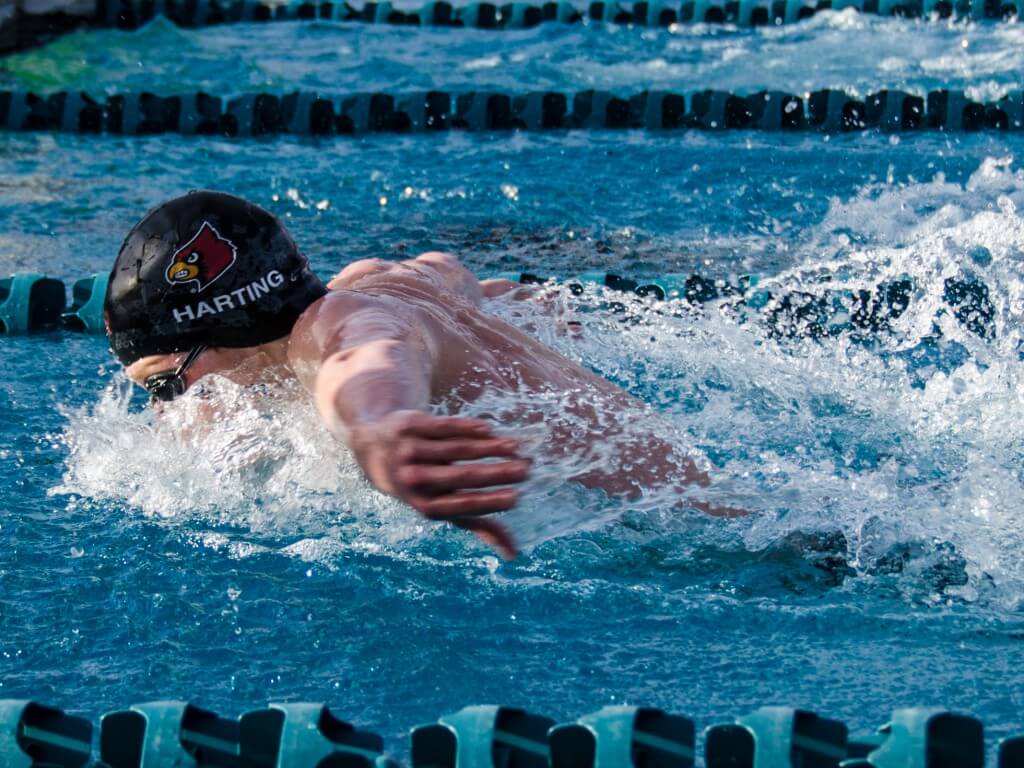Swimmin’ in the Wind: 6 Ways To Swim Fast in Windy Conditions.

Want to challenge yourself?
Want to face and overcome the toughest conditions nature can throw at you?
Want to learn how to get up and race fast when everyone else is ducking for cover and looking for a nice cup of hot chocolate?
The answer my friend is Swimmin’ in the Wind…the answer is Swimmin’ in the wind.
Swimming in Wind: A Matter of Attitude.
First – and most important – everyone in the race has to experience the same windy conditions.
Accept that it’s windy – and that conditions are not ideal for racing. You can’t change it. Accept it. Deal with it. And choose to swim fast.
Sure – you can leave your track suit on a little longer to keep warm before you race.
You can try to keep out of the wind between races and try to keep as warm and as comfortable as possible as you sit and wait in the Stands.
But in the end – you’ve got to race – and race fast – regardless of the environmental conditions you have to face at the Meet.
For example.
Imagine two swimmers – in the same race – and facing the same challenges of swimming in wind.
Swimmer A: “This is hopeless. It’s so windy. I hate these conditions. I just know I’ll swim slow”.
Swimmer B: “It’s windy tonight. The wind is coming down the pool so I’ve got it in front of me in the first 50. I’ll stay down a little longer off my start, try to stay relaxed on my first lap and then really attack the wall so I can come back fast and take advantage of the wind being behind me”.
Your attitude determines your outcome!
Swimming in Wind: Four Types of Wind
There are four different types of wind that can potentially impact on your competition performance:
- Head-winds, i.e. winds coming straight up the pool into your face.
- Tail-winds, i.e. winds coming from behind you as you swim.
- Cross-winds, i.e. winds that come from the left or the right across your lane.
- Variable-direction-winds, i.e. winds that seem to change direction from moment to moment, swirling and twirling and not seeming to follow any one direction or path.
Doesn’t matter what kind of wind it is, the goal is the same: figure out how to swim fast regardless of what kind of wind it is.
Working with Wind: How to Plan to Swim Fast when Swimming in Wind
Here’s a simple four step process to help you come up with a strategy to swim fast when swimming in wind:
- Is it windy? Yes or No. If No – start your usual warm up routine and don’t change your race plan. If Yes – go to Question 2.
- Is the wind likely to effect my race plan? Yes or No. If No – start your usual warm up routine and don’t change your race plan. If Yes – go to Question 3.
- How strong is the wind? Rate it on a scale of 1-10 with ten being a tornado and one being a gentle, light summer breeze. If less than 5 – start your usual warm up routine and don’t change your race plan. If you rate the wind more than 5 go to Question 4.
- How can I use these conditions to my advantage and swim fast?
6 Ways to Swim Fast When Swimming in Wind.
- Stay down. There’s no wind under the water so it makes sense to stay down a little longer off your starts and turns but…and this is a big but – only if you’ve practiced this in training. If you usually pop up at the 8 metre mark in races and then make a decision to stay down for 15 metres because it’s a little windy, you’ll soon realise there’s a price to pay for spending more time under-water.
- Go deeper. Again – go to the only place where there’s no wind – deep underwater. Practice both shallow push offs and deeper push offs in training so you can use either depending on the conditions you need to face on race day.
- Use the wind to your advantage. When it’s windy in training, deliberately practice swimming fast. Make windy conditions “your” conditions. Become a swimmer who’s known for being able to overcome any conditions, anywhere, anytime and you build a reputation as the swimmer who always performs well in tough conditions.
- Change your pacing strategies. It’s difficult to maintain the same pace into a strong head wind as it is when you’re being followed by a strong tail wind. So for example, if you’d like to hit 1:15 for your hundred and your race plan called for a 36 / 39 split, change it to maybe a 37 / 38 split. If it’s a particularly strong head wind you may need to look at swimming a “negative” split, e.g. 38 / 37 split. And…you guessed it! Practice being able to swim your race with variable pacing strategies in training.
- Change your expectations. Part of being successful when swimming in wind is accepting that this may not be the night you break the State record or swim a lot of PB swims. It doesn’t mean it’s impossible to break records in tough conditions. You’ve only got to see what the Mighty Katie Ledecky did at the 2014 Pan Pacs where she broke world records in cold, wet and windy conditions tough enough to make your average Marine cry. But for most “mortals”, when the conditions are really tough, change your expectations from “tonight’s a record night” to “tonight’s a night where I give everything I’ve got and do all I can to swim fast”.
- Swim with your head. Swimming in wind is the perfect time to swim inside your head. Maybe you could pretend that when you swim with the wind behind you you’re actually swimming “downhill”. Or perhaps imagine that you’re slicing through the head wind with your arms as you swim into it. Or imagine the cross-wind is getting under your arms and lifting you down the pool. Playing these swimming mind games is a surprisingly powerful and important tool to use when striving to swim fast if the wind is strong.
Summary:
- As with all aspects of your swimming – it comes down to preparation. When it’s raining – go to practice. When it’s cold – go to practice. When it’s windy – go to practice. Learn to thrive in all conditions and then no matter what happens on race day you can deal with it and swim fast.
- Don’t ignore the conditions. Accept that it’s windy or cold or rainy – and plan a strategy to deal with it.
- No excuses. After you race – avoid using the phrase “That was ok considering the conditions”. It was fast or it wasn’t. Don’t use the conditions as an excuse.
Wayne Goldsmith




